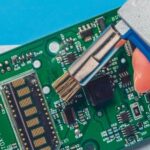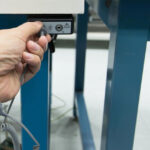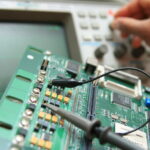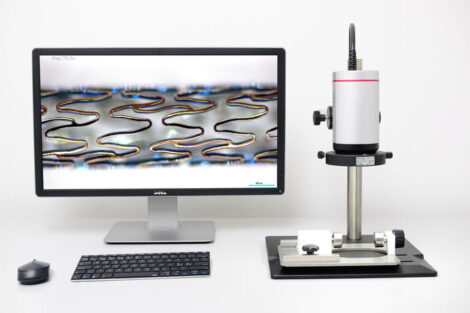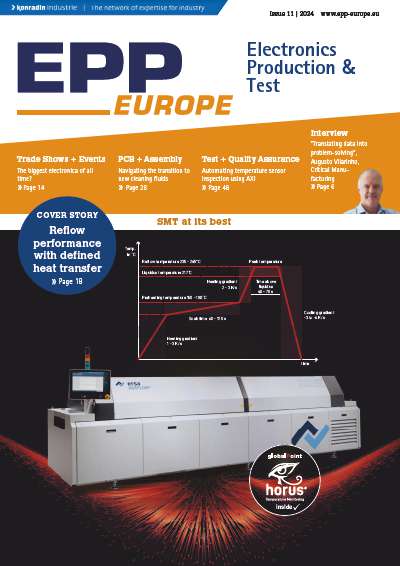ESD can damage electronic components and result in significant losses for electronics manufacturing companies in the form of warranty returns, rework, scrapped boards, wasted time and missed deadlines. This is not only costly, but may also negatively affect the company’s reputation.
Experts estimate that up to one third of PCB failures are from ESD. Today’s electronic assemblies are smaller, more complex and incorporate increasingly more expensive parts, so it makes sense to reduce and control ESD and protect PCBs during assembly.
What is ESD?
Electrostatic discharge is caused by two surfaces or objects at different levels of electrostatic charge coming into close contact with each other. When one is positively charged, and the other negatively charged, the protons and electrons that carry these charges attempt to balance each other out by rapidly exchanging at the point of contact. The sudden release or discharge of the built-up charge causes an ESD ‘spike’.
Although ESD is invisible, it is a severe threat in many electronics manufacturing facilities. Static charges of all proportions can cause irreversible damage to delicate electronic components including resistors, capacitors, inductors, diodes, integrated circuits, MOSFETs, transformers, transistors, integrated circuits, sensors, switches and relays.
There are two common types of ESD damage: catastrophic and latent. Catastrophic failure causes permanent damage so that the PCB will never function again. Although easier to detect during the inspection, catastrophic damage requires a complete PCB replacement.
Latent ESD damage may not be immediately apparent. The PCB can be partially degraded and continue to function. However, the component may lose overall function or have intermittent faults during its lifetime, resulting in an unreliable electronic device.
Although latent damage accounts for the biggest cause of ESD failure, it is also harder to detect. A PCB with latent damage can still be undetected during rigorous testing. This makes failure from latent damage extremely costly to the manufacturer.
Where does ESD come from?
There are several ways in which ESD occurs, but the most common is through human touch. During everyday activities, the human body and some clothing store anywhere from just a few volts of static electricity to many thousands during a typical working day. When hand contact is made with the PCB, it often results in ESD.
An electronic manufacturing facility has many other circumstances where ESD could damage PCB assembly. For example, using ungrounded electrical equipment such as an oscilloscope when troubleshooting electronic circuitry is a major cause. However, it’s not just electronic equipment that causes ESD. Trolleys and conveyors can also build up friction or machinery or materials rubbing against each other to generate a charge. Even simple items like plastic cups placed near electronic circuitry can generate a charge.
Creating a rapid movement of air near an electronic assembly can be another source of ESD. For example, using compressed air to clean a PCB assembly, or placing a fan nearby on a hot day can be problematic.
Preventing ESD damage
In an ideal world, PCBs would be designed using components that are not sensitive to ESD. However, as electronic assemblies become smaller incorporating delicate components on compact, densely-packed boards, this is not an easy task. The more complex and sensitive a PCB becomes, the more challenging it is to prevent ESD.
Although it is impossible to prevent all ESD charges completely, there are several ways ESD can be reduced during SMT (surface mount technology) production.
Eliminating ESD from work area
The area where the PCB is made can significantly affect ESD. Some work spaces are more vulnerable to electrostatic discharge than others. For example, receiving, assembly, repair, cleaning, inspection and packaging are the most susceptible production areas. fortunately, practical procedures and measures can be implemented to reduce ESD in the work environment.
- Wear anti-static wrist straps or heel straps. ESD anti-static straps are a simple and effective way of dissipating static from workers. Wrist straps can be connected to a grounded line, keeping the person continuously grounded while they work on sensitive PCBs.
- Place conductive floor mats where technicians stand to help discharge static build-up from shoes.
- Establish protocols to ensure all workers wear anti-static clothing and shoe coverings.
- Ensure all work tables, equipment racks, floor mats and wrist straps are grounded.
- Prevent static build-up by maintaining the temperature to 22–18 °C. Also, keep air humidity between 40–70% in the production area. Humid air helps to dissipate static charge.
- Remove any unnecessary items from the work area. For example, plastic or polystyrene cups or even notepads and pens that can create an ESD charge.
- Ship all assembly parts and PCBs in static-controlled containers and packing materials.
Wipe away static
Static can easily build up within electronic manufacturing facilities. Work surfaces, where devices are assembled, to the tools used to clean and test PCBs can hold a static charge. Nearly everything in or around the production line can be affected, from wooden workbenches and vinyl chair cushions to computer monitors and plastic trays. Even electric soldering irons and reflow and wave soldering ovens are conductive.
When manufacturing PCBs, it is vital to remove any built-up static by dissipating the charge. This can be done by regularly wiping all items, including work surfaces and tools, with pre-saturated, ESD-reducing cleaning wipes. By using a high-quality ESD cleaning wipe, contamination like fingerprints, grease and oil are cleaned off without leaving behind lint, debris or static charge. ESD cleaning wipes are excellent at removing contamination, but look for one with a low level of alcohol. Alcohol is an ideal non-conductive workplace cleaner, although it tends to dry out mats, cause fissures or leave surfaces brittle.
Static dissipating PCB cleaning tools
Some flux removers and other cleaning fluids used within PCB production can generate as much as 12,000 volts of ESD, which is more than enough to damage or destroy electronic components. This build-up of ESD comes from the friction of the static molecules as they move down the plastic spray tube, which is commonly used to dispense these cleaning products. There are, however, alternative tools that can be used with cleaning aerosols to dissipate any static charge.
By removing the plastic straw and using a static zapping dispensing tool that attaches to the top of the aerosol can, ESD can be reduced. Made from durable aluminium and stainless steel, this static dissipating tool makes the user part of the grounding circuit by maintaining contact with it. This reduces static charges to just 50 volts to prevent ESD damage.
Compressed air may cause damage
Cleaning and drying PCB assemblies with compressed air may increase ESD. Fast moving air can cause charge separation, resulting in a build-up of static. To reduce the risk of ESD, use alternative cleaning tools and fluids specifically developed to dissipate the static and remove any contamination quickly.
Static-safe flux remover dispenser
An ESD-safe controlled flux remover dispensing system is another tool that helps to eliminate static when cleaning PCBs. It not only improves the outcome of benchtop cleaning but improves ESD safety.
The dispensing system usually includes brush and syringe attachments. These help to clean under low surface mounted components for thorough cleaning. The scrubbing action of the brushes increases the effectiveness of the fluid, which loosens and rinses away contaminants with little effort and minimal cleaner.
Using a controlled dispensing system keeps the flux remover clean for each use delivering the correct amount of fluid to wet the PCB completely but without overspray or waste. It reduces fluid use by up to 60% to help cut cleaning costs and ensure every drop inside the aerosol can is used. This in turn makes it easier to dispose of as non-hazardous waste.
Cleaning with this tool also helps to control ESD by carrying down any charges to the ground, cutting the static going to the PCB, its microchips and other sensitive electronic components.
Removing ESD to enhance PCB reliability
ESD has no place in modern electronics manufacturing facilities. This invisible threat can have catastrophic effects on PCBs. As PCB assemblies become miniaturised and multi-functionalised, with highly-sensitive components, the capacity to withstand applicable voltage is reduced, making them vulnerable to in-the-field failure. It is, therefore, important to ensure any ESD is removed.
By controlling ESD, production efficiency can be improved, product quality and reliability can be increased and costs reduced.
Implementing effective measures to prevent ESD in the workplace is fundamental. With the correct static-dissipating cleaning tools and fluids, electronic assemblies can be protected.






